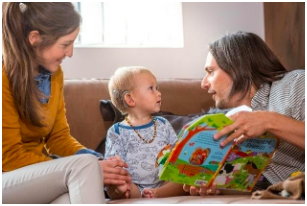Just like us, children go through feeling hard emotions, such as anger, worry, disappointment, and sadness. As a kid, they may not have the words or skills to communicate and overcome those emotions on their own. As caregivers, we need to be there to help them gain these skills of knowing how to self-regulate and manage their emotions in healthier ways. Below are some starting ways to begin to help your child of any age manage their “BIG” feelings

1. Teach your child about emotions and help them recognize them!
Talk it out! – Have an open conversation about ALL kinds of feelings, the good ones and the hard ones. Some days we may feel happy and some days we may feel mad. At the end of the day, all feelings are okay to have – even the harder ones like anger. You can do this by telling them, “I see that you’re feeling mad and it’s okay to feel that.” You can also start by narrating the moments you catch them in their feelings. For example:“You look sad right now, I see that you’re crying and frowning…” or “It seems like you’re upset because someone took a toy you were playing with.” “I see that your face is turning red and your fists are clenched. It looks like you may be feeling frustrated.”
Use Books and Shows! – Feel free to describe the feelings of whatever show they may be watching or books they may be reading from! These are perfect opportunities to ask “How do you think this character feels?” In these moments, they are gaining more awareness of what emotions they’re feeling as well, and can learn in calmer situations how to identify their own emotions later.
Label, Label, Label! – You can start small by labeling and introducing simple feeling words such as angry, sad, happy. Then, as you see that your child is beginning to grasp these concepts, go deeper and introduce words such as frustrated, worried, shy, and excited.
2. Validate Their Feelings and Show Empathy
When your child is in their big feels, take some time to slow down and validate their emotions. Validation makes children know their feelings make sense and are okay to have, even if they are hard. It’s easy as a caregiver to quickly say whatever is on our mind, such as “Stop crying” or “You are okay, its not a big deal.” But when you minimize your child’s feelings, they come to understand that their feelings are wrong or shameful. In these moments, take some time to step back and take a few deep breaths yourself and model how you manage your own emotions. For example: “I understand you feel frustrated that we have to leave the playground. It’s normal to feel that way.” Or “I can see why that would make you cry. That must’ve been hard.”
Show that you accept what your child is feeling even though you may not understand the underlying reason. Remind them that feelings come and go

3. Teach and Practice Coping Skills
Coping skills are great for helping children (and even us) deal with big emotions. Practice and teach these in their calm and regulated moments and not when they are emotionally dysregulated. It is nearly impossible for a child to learn during a moment of big feelings. This is NOT a good time to try! Instead, a great way to teach them is through modeling them, such as taking deep breaths, narrating good and hard feelings and demonstrating how you would handle a challenging moment. Children watch and copy what they see…make sure they are imitating a positive model for coping!
If you feel your child needs help navigating big feelings and that you could also benefit from how to coach your child to cope with these, please call today to schedule a Social Worker assessment from our pediatric professionals. We can be reached at 773-687-9241 to help with all feelings, big and small!







